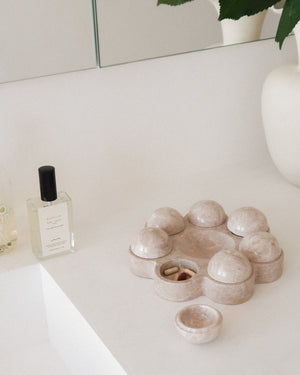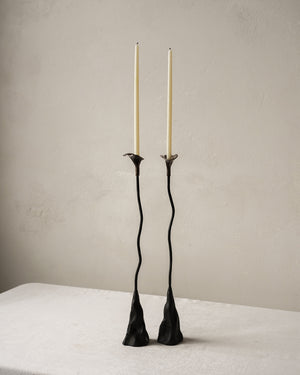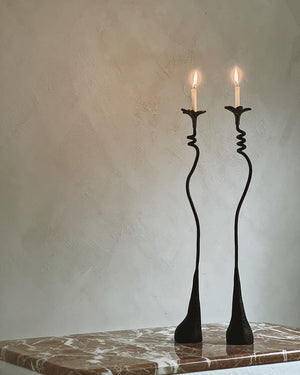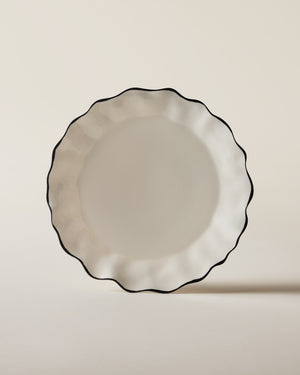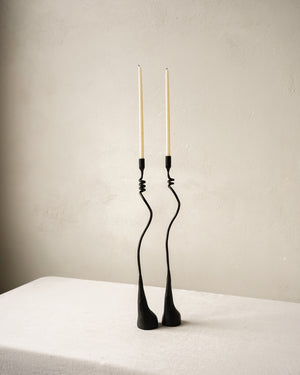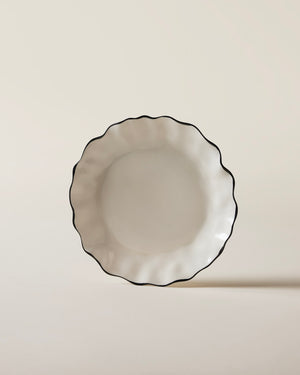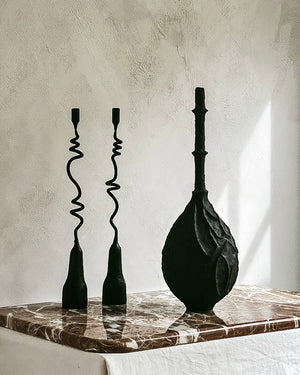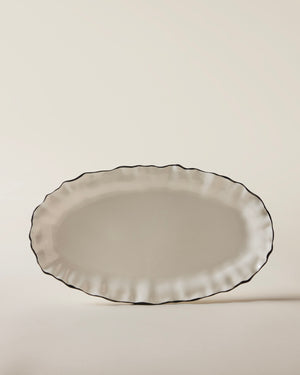Studio Visit: Abid Javed

This Spring we had the pleasure to meet with Abid Javed in his east London studio and see the behind-the-scenes of his creative process. Abid's art form stems from the desire to compel his audience to expand their definition of “natural beauty” beyond the observable world with the naked eye. While earning his Ph.D. in molecular biology, Javed felt compelled to translate the shapes he saw under the microscope into tangible forms which led Javed to enroll in a ceramics class in London. He found the traditional pinch and coil method of shaping clay the ideal physical and interactive process for creating his “molecular objects,” sculptures, and vessels inspired by microscopic biological forms.
Our Q&A with Abid in his Hackney-based studio:
What was your main source of inspiration for designing your studio?
I think the studio space took shape organically - as a lot of things in my life do. I knew I wanted natural lighting and some plants around me. I wanted a space that is conducive to getting inspired everyday, feeling energized to make and being able to interact with people yet still have my little cocoon to create. So the space itself was put together such that it allows me to make my work but also interact with fellow artists working in their own space. The space gets gorgeous natural lighting and I get to people-watch from the window on the hustle and bustle that goes down in hackney.
What does a day in your studio look like? & how did you decide on the final space?
I either come in first thing in the morning or after my lab work in the evening. So depending on the agenda and tasks at hand, the morning typically starts with a coffee and the evening with a tea. Then I put some music on (essentials) and go through what I need to go through that day. The decision on the space was based on the location (being in the beating heart of east London, Hackney), the community of artists and creatives, the people who share my studio space with and ultimately the lighting of the space.

Do you have any studio must-haves (a podcast, playlist, snacks)?
You are talking my language - yes, absolutely! I think there are definitely days where I don’t want any sound and I want to work in the quiet (which can only happen early mornings in Hackney) but I usually have a music playlist or a podcast/audiobook at the studio. It ranges between electronic, pop to sometimes classical and sometimes super alternative (sourcing creative thoughts). And snacks - I usually have biscuits, nuts or crisps to nibble on (fuelling your body any which way).
|
Pleomorph No. 3 |
Pleomorph No. 2 |
Many artists and creators consider the place where they create as important as the final artwork. Do you find that your studio is a haven that inspires you to produce your best work? Why or why not?
Absolutely. Without a studio space, I don’t think I would have room to evolve creatively. I am definitely outgrowing it and at times I do find it small as my hands want to go big but the location, the space, the people I share the space with make up for an inspiring environment to make! I have found my studio in hackney particularly to be a place where I come to think and plan on new ideas, where I can be experimental and be bold with ideas and try out new things.

How would you describe your artistic style in a few words?
It’s organic, biomorphic, elegant and wild. Alien-esque and mercurial at times (depending on where I am headspace wise).
Let us delve into your background in molecular biology. How did you transition from this to becoming a sculptor? And how do you see your background in molecular biology affect the outcome of your pieces?
Sure. Growing up I realized I had a creative part of me that I began to nurture by drawing and painting. Sculptures came to me a little later, when I was doing my PhD in molecular biology. I was looking at molecules under the microscope and I had this desire to give them physical, tangible forms in real spaces. But I had no means or knowledge at the time, until I connected with clay and started to get experience in making in clay. It was then that I had to undergo a steep learning curve on the concept of sculptures: how to see, how to express feeling, the use of space, bodies. And thanks to pioneers and me being a good student, I quickly began my training process - training my eyes, training my hands and mind. I picked up notes to realise how I want to translate and communicate my ideas into sculptural forms. My training in science has definitely helped when it comes to research and critical thinking. It is often overlooked in the arts and crafts space but it is absolutely key, for any discipline, to be able to go out and explore, digest information and critically think on it before you take the next action. It has helped me develop ideas that I never imagined, as well as a desire to explore (like a curious kid).

We know you take influences from Islamic art & geometry- could you delve deeper into this and tell us how you see the two intertwine with your methods and sculptures?
Absolutely. Before I began working in sculptures, I wanted to connect with my heritage artistically and see how I can explore that. This was particularly after I came back from a trip in Cordoba, Spain and seeing the rich Islamic arts past left by the caliphates. In Islamic arts, there is this notion of representing beauty, ideas around what heaven is/would be for life after life. And to this day, I have that imbued in me - how am I able to capture or think around aspects of nature (biology) and it’s facets of elegance, subtle charms. At the same time, I am also in tune with the opposite side of beauty (when things are wild), but my understanding in Islamic arts have allowed me to connect with looking at beauty in a spiritual way. With that comes geometry - the mathematical, seamless construction of perfection: whether it’s nature, arts, architecture or generally the world we live in. Having worked with geometrical molecules, I often translate geometric ideas into design; construction of stools, tables as well as sculptures.
So when I come to make, subconsciously my mind is at work with all these ingredients at play for working on a particular piece.
|
Pleomorph No. 4 |
Pleomorph No. 1 |
Over here at LES, we are amazed by your ability to create such a range of hand- built ceramics. Since ceramic sculpting is your primary medium, does your studio require anything different that a gilderr painter may not have?
A high-temperature electric kiln is probably what I can think of. Without it, I would not be able to achieve the stone-like quality of my pieces. Ceramics is unique in that sense that although you can make with clay pretty much anywhere, even firing your pieces in a homemade kiln, but space and power components are essentials to converting raw clay into a finished form.

Your one-of-a-kind pieces have such a signature and quality look to it. Besides ceramics, what other materials are you curious about bringing into your studio?
Since my last show - I have been branching out into paper, beeswax and glass.
Paper I gravitated towards instantly, when I started doing lighting objects, as it seemed like an organic material to complement with ceramics. Also I have been obsessed with Akari lamps by Isamu Noguchi and my sculpting mind wanted to tap into that space, in my own language, to see what can be achieved. So recently I have done a collection of lamps with planar paper lamp shades that produce diffuse light in a directional way (Objets Mito lamps).
Beeswax I started exploring for its material properties as well as moving away from the traditional idea of using wax in candles - I like the fact that you can mold beeswax into sculptural forms and I designed a vessel for my show last year that would hold water to be used as an ikebana vase.
Glass I have been fascinated with ever since the desire to do sculptures came into me. If it wasn’t for clay, I would have trained in glass and probably gone the other way to exploring ceramics. But given ceramics and glass are closely related as materials (both containing silica, both requiring heat to make): I am exploring how glass can be complemented with ceramics at the moment. I would say watch this space.
|
Augmin Candelabra in Oat |
Small Exo Lamp in Oat |
What are your favorite inspirations you find in the natural, every-day world that really transform your art?
The idea of seamless-ness in nature fascinates me. I try to pay attention to this in everyday life or when I’m at work under the microscope, because fleeting moments where nature is effortlessly at play is a total joy to experience. And that for me fuels new ways of thinking - how can I make my work seem like it’s effortlessly connected together, itself - being.
